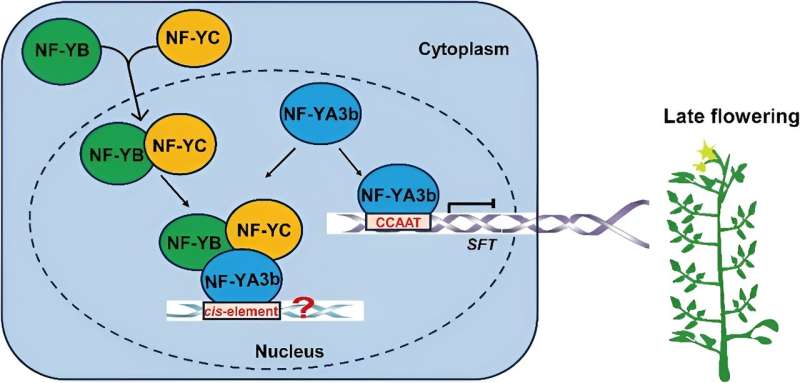This article has been reviewed according to Science X's editorial process and policies. Editors have highlighted the following attributes while ensuring the content's credibility:
fact-checked
peer-reviewed publication
proofread
Tomato timekeeper: SlNF-YA3b gene's role in flowering time revealed

Controlling the timing of flowering in crops is crucial for optimizing yields and adapting to climate changes. Researchers have identified a specific gene in tomatoes that regulates this critical phase, providing a significant step forward in the ability to fine-tune agricultural practices and enhance productivity.
Flowering time is crucial for crop yield and quality, directly affecting seed and fruit production. While extensive research has focused on flowering regulation in model plants like Arabidopsis and rice, the mechanisms in tomatoes remain less understood.
In tomatoes, flowering time impacts both yield and the synchronization of fruit production, which is vital for commercial farming. Addressing these challenges requires in-depth research to uncover the genetic factors controlling flowering time in tomatoes, aiming to enhance crop management practices and boost agricultural productivity.
A team from Huazhong Agricultural University, along with collaborators from Northwest A&F University, Zhumadian Academy of Agricultural Sciences, and the University of Idaho, published their findings in the journal Horticulture Research on April 2, 2024.
They discovered that the gene SlNF-YA3b regulates flowering time in tomatoes by binding to the promoter of the SINGLE FLOWER TRUSS (SFT) gene.
The study explored the NF-Y transcription factor family, focusing on the NF-YA subunit, SlNF-YA3b. Using CRISPR/Cas9 technology, researchers created tomato plants with knocked-out SlNF-YA3b, leading to significantly earlier flowering compared to wild-type plants. Conversely, overexpressing SlNF-YA3b delayed flowering.
Biochemical assays confirmed that SlNF-YA3b binds directly to the CCAAT elements of the SFT gene promoter, repressing its expression. This suggests that SlNF-YA3b functions as a flowering time repressor in tomatoes.
The study's findings highlight the critical role of SlNF-YA3b in regulating flowering time, offering new insights into the molecular mechanisms of tomato flowering.
These discoveries pave the way for genetic manipulation to control flowering time, potentially improving crop yield and synchronization, thereby enhancing agricultural productivity and efficiency.
The discovery of SlNF-YA3b's role in flowering time regulation has significant potential applications in agriculture.
By manipulating this gene, it may be possible to control the timing of flowering to optimize fruit production and improve crop resilience to environmental changes. This research offers a promising path for enhancing the efficiency and productivity of tomato cultivation.
More information: Dedi Zhang et al, Nuclear factor Y-A3b binds to the SINGLE FLOWER TRUSS promoter and regulates flowering time in tomato, Horticulture Research (2024). DOI: 10.1093/hr/uhae088
Journal information: Horticulture Research
Provided by TranSpread




















